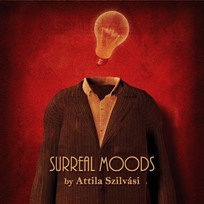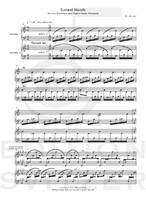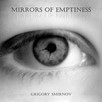
Surreal Moods
Composer: Attila Szilvási
Instrument: Two Marimbas and Tape
Level: unknown
Published: 2013
Price: €35.00
Item details
-
Description +
-
Duration: 11 min.
Surreal Moods is written for two 5-octave marimbas and electronic background music for a 3-piece musical play. The title refers to the surreal relations of the three pieces. The three moods are represented in three sections in the following order: present, past and future. As the play is polystylistic, each part of this piece may be considered as separate genres though the structuring principles typical of the genres are mixed, emphasising the surreal atmosphere and mood of the play.
“In the first part, I drew inspiration from recent and popular musical genres which I enriched with imitations and motifs used in early music. For example, the beginning motif of Dies Irea appears at the peak of the first piece to the accompaniment of a marimba complement.
In the second part, the accompaniment is changed to instruments used in classical, symphony orchestras to which the marimbas play a pattern-based layer popular in modern music in addition to the main melody. Here, the music is led to the third part with the development of the pattern appearing in the first piece. I am expressing the mystery and the obscurity of the third time spectrum with a new technique of playing with timbale mallets.
Since my aim was to create a cycle with exploring all the three eras, we reach the initial atmosphere and mood by the end of the piece.”
Surreal Moods is commissioned by Maraca2 for their American tour in 2011.
-
-
Instrumentation +
-
Two Marimbas and Tape
-
-
Watch+
-
Performed by Jose Uzcategui and Ashley Ridenour
-
-
About the composer +
-
Attila Szilvási was born in 1982 in Budapest, Hungary. He started to play percussion at 10. In 1996 he was accepted to the Weiner Leó Secondary School of Music in Budapest where besides percussion he also studied composition. He was taught by Tibor Nemes, Lóránt Hajdú and Dénes Legány. He continued on his percussion studies at the Liszt Academy of Music in the faculty in Debrecen at István Szabó, he was granted master in percussion in 2006, in conducting in 2008. At present he is the principal percussionist at the Dohnányi Orchestra in Budapest, percussionist at the Budapest Concert Orchestra (MÁV). He played in almost all orchestras in Budapest and in several Symphonic Orchestras in Hungary.
During his studies he was a member of Talamba and SONUS percussion groups, where he got to know numerous inland and foreign contemporary compositions. At that time he also took part in several music competitions and was awarded the following: National University Percussion Solo Competition 2nd prize and special prize in 2002, 1st prize in 2003, International Marimba Competition in Belgium semifinalist in 2004.
He started to compose very early. His first pieces were mainly for piano, wind and percussion instruments, but lately he has concentrated on percussion, in particular on solo instrument pieces with electronic music accompaniment. In his master’s concert in 2006 his composition Gladiators of the Past and Future was played, which consists of two movements, composed for organ, percussion solo and synchronal-controlled electronic music accompaniment.
-
-
Reviews +
-
Review (Percussive Notes 62, July 2014)
Composed as a musical play in three parts, “Surreal Moods” is a challenging 11-minute work that embodies the composer’s attempt at representing three moods. These moods are characterized in three sections following the order of present, past, and future.
Attila Szilvási tries to combine time periods within each section through the use of contrasting ideas. A good example of this occurs within the first section where the present is represented by popular musical genres of today in the playback part while the marimbas harken to the past with statements of the “Dies Irae.”
Technically, both performers must be able to navigate numerous meter changes as well as some tempo changes. While there are a few areas where the players are in unison, much of the piece has them performing separate lines or the same line displaced from one another. Thankfully the playback (which has a number of options available as a free download from the publisher’s website) comes with an option for the electronic soundscape to be in one channel while a click track is in the other.
In addition to the rhythmic demands of the piece, performers will also need to be established four-mallet players as the work relies on all of the major stroke types. Performers should also prepare themselves for performing on the edges of the bars with the shafts of the mallets.
One final item to note is the use of timbale sticks as implements on the marimba. This is the composer’s way of representing “the mystery and obscurity” of the future. The music indicates a forte while holding four timbale sticks, which potentially could damage instruments. Thankfully, a little goes a long way with these implements, so very little velocity is required to make the bars speak.
“Surreal Moods” is an interesting new work that will challenge performers on a number of levels. The spectacle of observing performers display highly demanding technical music combined with the pop influence of the playback will surely be an enjoyable experience for audience members, as well as highly rewarding for the performers.
—Brian Nozny
-
-
Credits +
-
Front Cover graphics and layout: Ronni Kot Wenzell
Engraving: Attila Szilvási
Foreword: Attila Szilvási
Printed in Copenhagen, Denmark
Copyright © Edition Svitzer
www.editionsvitzer.com
-





